Phone battery dead? Learn how to tell time with the Big Dipper. Also, don’t miss a remarkable transit of Ceres in front of the bright spiral galaxy M100.
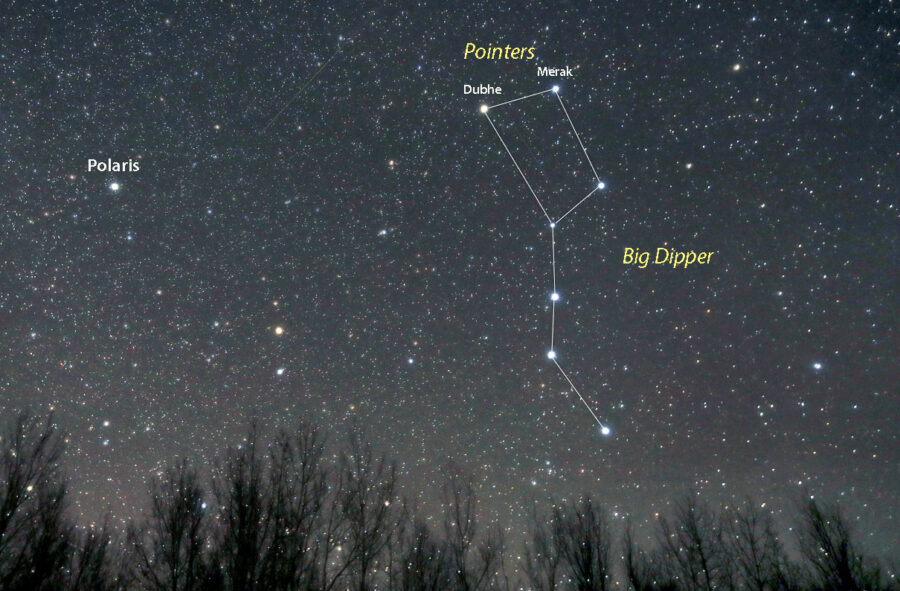
Bob King
Time-telling goes way back. Early humans watched the daily and nightly perambulations of the Sun and Moon to mark the passage of time. Even the shadow of a stick jabbed into the ground could serve as a primitive clock. The earliest manufactured timekeeping devices were sundials and water clocks. In a water clock, water dripped through a hole in the bottom of one container into another. Tower clocks that marked the hour by sounding bells appeared in the late 13th century. Clocks with familiar faces and hands made their appearance in the 1700s.
Three hundred years later, cell phones and digital clocks help us keep track of the time. Cell phones get their time directly from Global Positioning (GPS) satellites or through the nearest cell tower, which also uses GPS. Each of the current 31 GPS satellites (at least 24 are operational at any time) houses multiple atomic clocks that determine the time to within 100 billionths of a second.

Paulsava / CC BY-SA 4.0
Atomic clocks measure the length of a second — the basic unit of all modern timekeeping — is the time that elapses during 9,192,631,770 transitions from a lower to a higher energy state of the isotope cesium-133 when stimulated by microwave radiation. Far removed from our everyday experience of time, the “vibrations” are so precise, atomic clocks are accurate to 1 second in about 100 million years.
Although considerably less precise, the ancient way of telling time by the stars will still get you by in a pinch. I like to take a walk most nights, turning left at the end of my driveway and ambling north. When it’s clear, I always see the Big Dipper. In spring, those seven bright stars wheel nearly overhead; in fall they skirt the treetops. The two stars at the end of the bucket, Dubhe and Merak, make up an asterism called the Pointers. Shoot an imaginary arrow through them, and it will point you to Polaris, the North Star.
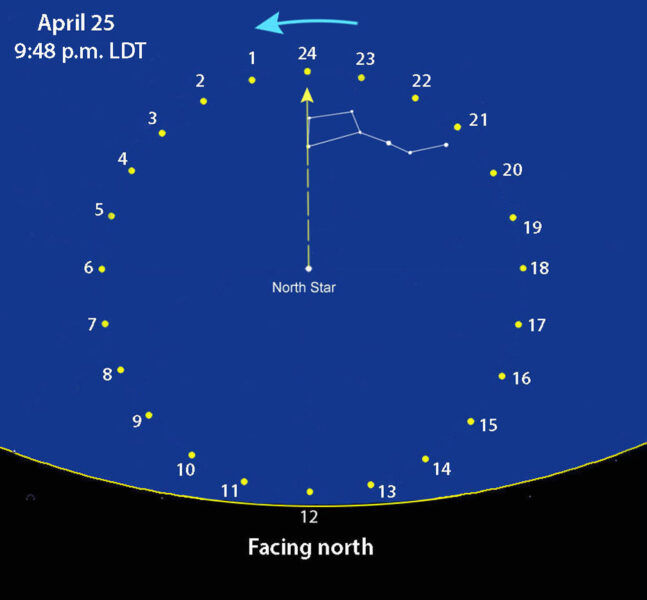
Stellarium with additions by Bob King
To make our stellar timepiece, we start at Polaris and treat it as the center of a classic analog clock. A line extended from the North Star to the Pointers becomes the hour hand that sweeps out a circle in the northern sky every 24 hours. A normal analog clock displays 12 hours with the noon/midnight hour at top and 6 p.m./a.m. at the bottom. Our sky clock operates on 24-hour time so its clock face has 24 hours with the 24/0 hour at the top of the "dial" and the 12-hour spot at the bottom. As the Earth turns, the clock's hour hand runs backwards (counterclockwise) at the rate of 15° per hour.
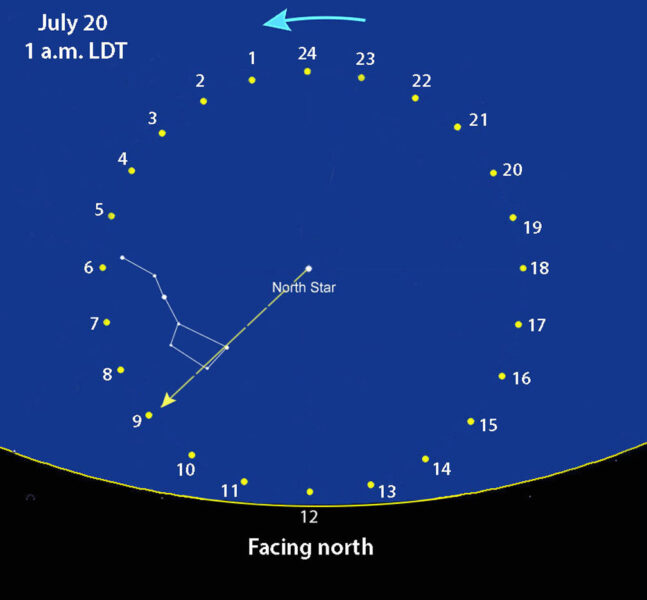
Stellarium with additions by Bob King
Like a broken watch that tells the correct time twice a day, the Dipper clock gives the correct time on March 6th. On that date, if the Polaris-Pointers hour hand points to 22, it’s 10 p.m. If 19, it’s 7 p.m. For all other dates, use this simple equation:
Time = Dipper Time – (2 x number of months since March 6th)
For example, if you face north on the night of April 25th and notice that the celestial hour hand points to 24:00 on the clock, the approximate time will be:
Time = 24 – (2 x 1.6 months) = 24 – 3.2, which is 20.8 hours on the 24-hour clock
Convert the decimal to minutes (0.8 x 60) to get 8:48 p.m. local standard time (LST).
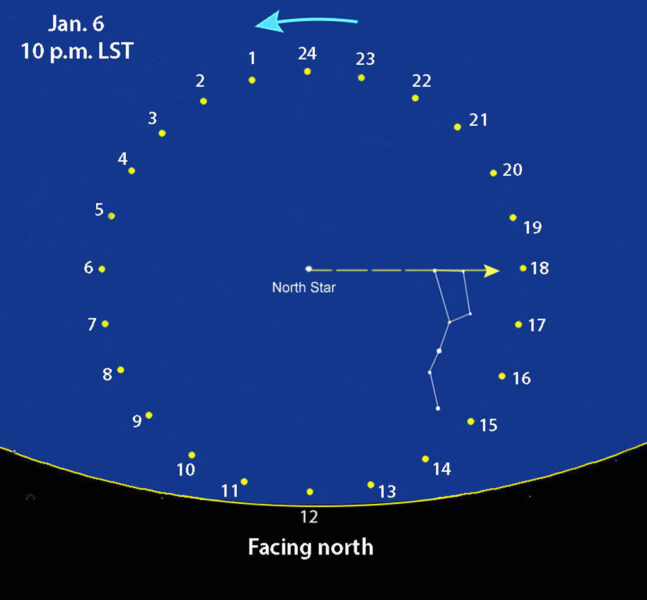
Stellarium with additions by Bob King
When daylight-saving time is in effect remember to add an hour to the Dipper time. When we do this, our crude clock reads 9:48 p.m. local daylight time (LDT). The actual time (based on computer simulation) is 10 p.m., so that's pretty close.
In our calculation, the solution was a positive number. If your answer is negative, subtract it from midnight (24) for the correct time. Based on my own experience with the Dipper clock I've found it accurate to within about 30 minutes. Keep in mind that your time may vary somewhat depending on your location in your time zone — our celestial clock will be a little behind true time if you live toward the western end of the time zone and a little ahead if you’re in the east.
Throughout human history, increasing precision in timekeeping has pushed the advancement of both technology and science. Still, it's fun to look back and take pleasure in knowing that the celestial gears continue to hum along.
Ceres meets M100
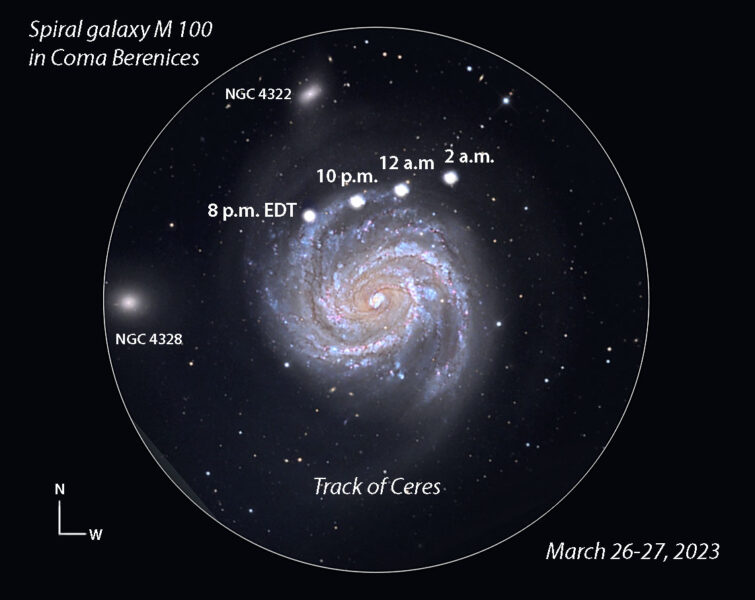
Stellarium with additions by Bob King
Ceres, the largest asteroid and one of five dwarf planets, reaches opposition on March 21st at magnitude 6.9. Any pair of binoculars will show it as a "star" moving slowly westward across Coma Berenices not far from Leo's Tail. This region of the sky is well known for its plethora of galaxies sought after by amateurs when the snow finally melts away and spring returns. By good fortune Ceres will pass directly in front of the bright 9th-magnitude spiral galaxy M100 on the night of March 26–27. For a few hours it will mimic a brilliant telescopic supernova beaming from one of the galaxy's arms.
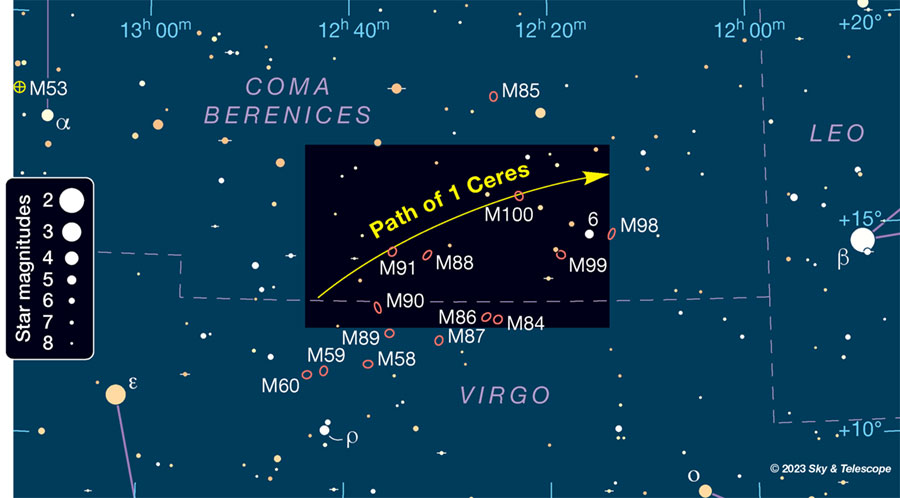
How fun to think that despite their apparent proximity Ceres shines from the piddling distance of 240 million kilometers compared to the galaxy's 56 million light-years. For a brief time their light will be co-mingled in breathtaking fashion. A 4-inch telescope will easily show the galaxy as a fuzzy patch with a brighter core, but to see the spiral arms you'll need at least an 8-inch instrument.
If you get skunked by bad weather, Italian astronomer Gianluca Masi plans to livestream the transit starting on March 26th at 11 p.m. EDT (3:00 UT, March 27th) on his Virtual Telescope site. Hopefully, we'll all get to relish one of the sky's finest illusions — effortlessly compressing three dimensions into two. Good luck!
 7
7









Comments
nowonda
March 16, 2023 at 5:01 pm
Hi Bob,
That's a very neat trick with the Big Dipper, never heard of it before. I was playing with your examples and the use of a backwards 24h clock irked me a bit, since we're normally using 12h clocks that aren't numbered backwards.
So I adjusted both the method and the formula just a tiny bit: find the "Dipper time" on a regular regular 12h celestial clock (even fractional hours, for example 3.5h, which is recommended for accuracy) and then use the following formula to calculate the real local time:
Real time = (24 - Dipper - months) x 2 (And add 1 for DST if needed)
That's it - you'll get the real local time in 24h format, without having to use a backward 24h clock to orient yourself and you even avoid going into the negative numbers: all results will be positive and if you get a result bigger than 24, just subtract 24 and you get your real time.
So it's just a small tweak that some may find easier to remember. I tested it using your examples and some others and it works, the formulas are equivalent.
Thank you for presenting the method, this one goes in the fun drawer, cheers!
You must be logged in to post a comment.
Bob KingPost Author
March 19, 2023 at 12:04 pm
Hi Nowonda,
Very interesting! I haven't tried your alternate method yet but it's intriguing. Thank you very much for sharing it with me and our readers.
You must be logged in to post a comment.
Anthony Barreiro
March 16, 2023 at 7:16 pm
Thanks Bob. When I'm away from city lights, I like to use the circumpolar stars to keep time at night, but without doing math. Just watching as the stars rotate around the north star, and knowing that 90 degrees equals six hours, you can tell about how long it's been since twilight, and how long until sunrise. I like to think that's how our ancestors did it. It's interesting to consider that the north circumpolar stars rotate "counterclockwise" because the first clocks with hands were made to mimic the motion of the Sun across the southern sky as seen from the northern hemisphere.
I've been enjoying watching Ceres through 10x42 binoculars since February 1. Sometimes the cloudy wet weather has lasted over a week without a break. If I can't find Ceres again, I cheat and use skysafari. I have to hide all the galaxies on the app, otherwise they hide all the stars!
You must be logged in to post a comment.
Bob KingPost Author
March 17, 2023 at 12:48 am
Hi Anthony,
Yes, I think Sun rules when it comes to clocks. You can't beat its universality. Regarding Ceres, that's one of the beauties of routine observation — one quickly becomes familiar with the field and can return night after night in a matter of seconds. Thanks for your comments, as always.
You must be logged in to post a comment.
Frank-ReedNavigation.com
March 18, 2023 at 6:10 pm
Just "eyeballing" the orientation of the pointer stars in the Dipper can get you the Sidereal Time, or the Local Mean Time, or the elapsed time (which is often all we're looking for) to the nearest hour or so. But with a simple historical device, built new with a few bits of cardboard, you can get time to the nearest 5-10 minutes. That device is known as a "nocturnal" or a "night dial" (because it's a night-time "sundial"). A few centuries back they were common tools both for astronomers, such as they were, and for practical people working at night, like mariners at sea. They're still popular projects for young students and scouting groups. There are instructions to make simple nocturnals on many websites. They work exactly like the simple chart here, but the cardboard pointer is more accurate, so long as the device is held vertically.
Nocturnals with a date adjustment, like the month adjustment described in the article, give LMT or Local Mean Time. This can be a long way from clock time, and not just because of Daylight Saving Time. For example in western Indiana or in most of the U.P. of Michigan, the time zone offset is 45-60 minutes from LMT (meaning that you would have to adjust the "Dipper Time" by up to an hour --and another hour on top during DST!). Large offsets of civil time from LMT are not rare around the world, and China is another extreme case where the offset can be two or three hours.
Without a date adjustment the pointer stars give us Local Sidereal Time. "SidT" used to be displayed on a big clock in every major observatory. It was the astronomer's friend because Local Sidereal Time is identical to the Right Ascension of the meridian (the north-south line passing through the observer's zenith). If you know your latitude, and you know SidT, then you know "what's up" in the sky. We still need a rule though to convert Dipper Time to SidT, but it's easy. Read the Dipper Time as Bob describes above, and then add 11h 5m.
Sidereal Time still has one practical use under a different name. For celestial navigators at sea, it's converted to degrees (15° to each hour) and known as LHA Aries (Local Hour Angle of Aries). Navigators are taught to calculate this based on date, time, and estimated longitude, but it can be read from the sky directly, using the Dipper or other constellations, just as described here. And this then can be used as an input to the +/- 40 mile correction required to get a ship's latitude right by observing the altitude of Polaris.
One other little navigation detail to get right: sometimes people here about this Dipper Time and nocturnals, even when setting up exhibits in museums, for example, and they think, "Aha! This is how they got time before those fancy chronometers were invented!" But no, those clocks or chronometers are meant to keep absolute time, GMT or equivalently today, UT --nothing local about it! A nocturnal or a sundial (or a sextant with some math to let it read sundial time) gives local time, eventually LMT. And then we compare that LMT with a well-regulated chronometer's GMT. Every hour of difference between the two implies 15° difference in longitude from Greenwich. Just that easy! 🙂
You must be logged in to post a comment.
Joe Slomka
March 21, 2023 at 2:05 pm
When my late father was a child in Poland, between WW1 and WW2, his farmer father showed him how to tell
the time the same way the article describes (minus the math).
You must be logged in to post a comment.
Rod
March 26, 2023 at 11:17 pm
I was able to view Ceres and M100 tonight. Posted an observation note here, https://skyandtelescope.org/astronomy-news/observing-news/this-weeks-sky-at-a-glance-march-24-april-2/
You must be logged in to post a comment.
You must be logged in to post a comment.